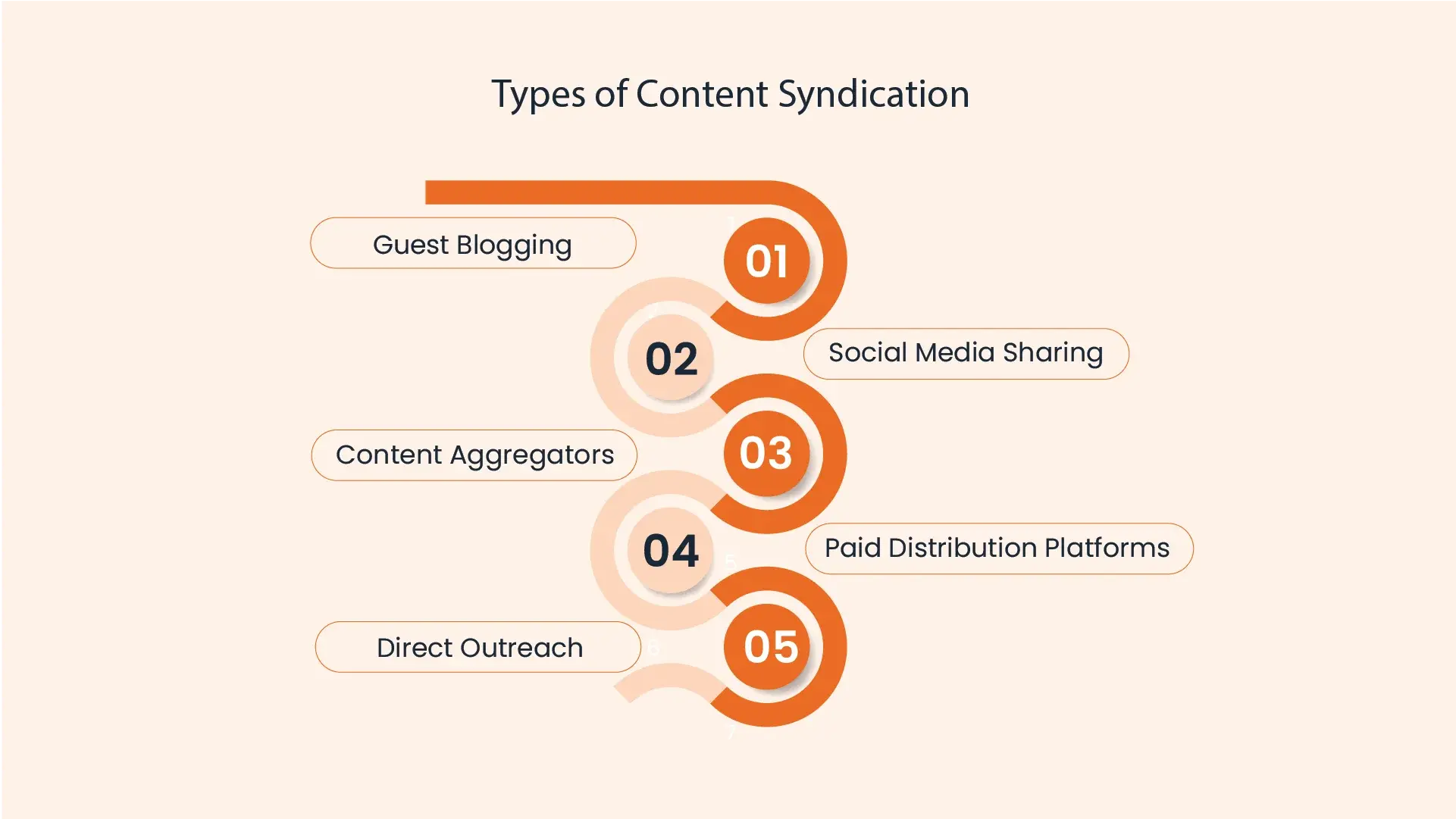
What is Content Syndication?
Content syndication implies republishing your existing content on relevant websites, platforms, and social media channels. It is all about reaching a wider audience who might love your posts and articles. How does it work?
- You create a high-quality piece of content (blog post, infographic, video).
- You find relevant platforms where your target audience spends time (industry blogs, social media groups).
- You strategically republish your content on these platforms, often with permission or following specific guidelines.
- It enables you to reach new audiences, drive traffic back to your website, and potentially boost your search engine ranking.
Why Share Content?
You make excellent content, but it is immediately lost in the online space. If this is your situation, you definitely need content syndication to boost your visibility! Who can benefit by sharing content?
- Businesses: Boost brand awareness, attract qualified leads, and establish industry authority.
- Bloggers: Expand their reach beyond their immediate audience and drive traffic to their blog.
- Content Creators: Increase content visibility and engagement across various platforms.
This approach will help you drive more traffic to your website, whether you are an online essay writing service or a travel blogger, improve your search engine rankings, and promote your brand. Besides, syndication generates high-quality backlinks that improve your site’s credibility and authority.
Types of Content Syndication
Once you are ready to expand your content’s reach, you need to find a suitable way to do it. There are several main types of content sharing:

- Guest blogging: You can write articles for established industry blogs or websites. It allows you to connect to a relevant audience and potentially get valuable backlinks.
- Social media sharing: Social media platforms like Facebook, Twitter, and LinkedIn will help you engage with your followers via content. They may share it further and expand your reach organically.
- Content aggregators: Platforms like Flipboard or Medium offer content in various niches. You can also post there and increase your chance of being noticed.
- Paid distribution platforms: Some services promote your content to a targeted audience based on demographics and interests. This is a great way to reach highly relevant users beyond your existing network.
- Direct outreach: You may directly contact any platform to offer a content swap. This allows you to exchange content and reach each other’s audiences.
Whatever method you choose, the key task is to place your content in front of the right audience.
Things to Consider When Choosing a Content Syndication Platform
The choice of syndication services from content syndication platforms is so rich that you can easily get lost. Here are some essentials to note when choosing a platform:
- Target audience: First of all, ask yourself who you are trying to reach. The response will immediately cut off the wrong platforms.
- Content fit: Check whether the platform you want to work with supports your content type (articles, videos, etc.).
- Cost vs. reach: You will find enough free services for content sharing, but they might have a limited reach. Sometimes, paid options are more appropriate as these offer more control and distribution.
- Credibility and audience: Opt for platforms with a good reputation and relevant audience in your industry.
- Tracking tools: Sharing content without knowing the results is a waste of time. Choose a platform that allows you to track content performance.
Best Content Syndication Platforms
The world of content syndication is broad, and your choice will depend on your goals, industry, target audience, and budget. Here are some of the top content syndication platforms to consider for different needs:
1. Outbrain
Outbrain is a content distribution service that uses native advertising to get your content seen. They place your content as sponsored recommendations on high-traffic websites like CNN, People, and ESPN. It’s a cost-per-click model, so you only pay when someone clicks. Businesses use it to promote content, while publishers use it to monetize their websites. Outbrain has around 557 million monthly users – this is a huge audience for content success.
Best for: Content marketers, brands, and publishers.
Price: Paid, a CPC pricing model.
2. Medium
Medium provides a unique space for individuals to publish articles, photos, audio, and videos free of charge. It is a true hub for readers to explore the opinions of both seasoned experts and emerging voices across various subjects. Users can share standalone posts or collaborate on curated publications. Medium encourages comments and discussions to further promote content. The platform has 100 million monthly users.
Best for: Thought leaders and writers.
Price: Free.
3. Quora
Quora is a dynamic platform where professionals and business owners can share their expertise in a question-answer form. By responding to queries from the community, they grow their professional reputation and personal brand. Quora brings together individuals seeking information and experts who offer valuable insights. Posting on this platform is a great method to generate organic traffic. Quora has over 400 million monthly visitors.
Best for: Thought leaders and professionals in various niches.
Price: Free.
4. Flipboard
Flipboard aggregates news, articles, images, and videos from various sources into personalized digital magazines. This magazine-like format is easy to navigate and browse. It functions as both a discovery tool for users to find new content and a distribution channel for publishers to reach a broader audience. Built-in sharing and following features help users build a community. Flipboard offers a unique way to expand your reach and engage your audience. The platform has 145 million monthly visitors.
Best for: Individual content creators.
Price: Free.
5. LinkedIn
LinkedIn has a massive network of professionals and is ideal for reaching potential clients or industry peers. It allows you to target your content to a highly relevant audience. You can share content in groups relevant to your niche and encourage discussions and networking around published content. Content sharing on LinkedIn establishes you as a thought leader in your field. This can enhance your brand reputation and attract potential clients or employers. The platform’s audience is 850 million users.
Best for: Thought leaders and B2B content.
Price: Free.
6. Reddit
On Reddit, you do not publish directly but strategically share within niche communities (subreddits). Content success relies on relevance – find the right subreddits and add proper content. Upvotes from the community propel your content to the top, and downvotes bury irrelevant posts. Active users build trust and organically promote their content within the community. Reddit is ideal for B2C brands seeking audience engagement and organic content promotion within specific online communities. The platform has over 2 billion active monthly users!
Best for: For individuals and businesses.
Price: A Free sign-up, a premium membership.
7. Tumblr
Tumblr is a platform known for microblogging and social networking. It is extensively used by content marketers for content syndication. Tumblr thrives on short-form content like text posts, images, GIFs, and videos. If your content aligns with these formats, it can be a good fit. Eye-catching visuals are crucial for grabbing attention on Tumblr’s fast-paced feed. The platform is effective for syndicating content within highly visual niches like art, photography, or fashion.
Best for: Microbloggers and visual content creators
Price: Free.
8. Taboola
Taboola specializes in native advertising. The platform displays your content as sponsored recommendations on high-traffic websites visited by your target audience. It is another powerful tool for content distribution, particularly for businesses that want to reach a wider audience and drive website traffic. The service has over 1.4 billion users every month.
Best for: Businesses.
Price: Paid.
9. Slideshare
SlideShare is designed for sharing presentations and documents online. It allows users to upload files such as PowerPoint presentations, PDFs, Keynote presentations, which can then be viewed publicly or privately. The platform syndicates content by allowing users to embed presentations on websites, share them via social media, and email them to others. It is excellent for professionals, educators, and businesses. The platform also offers analytics to track content performance.
Best for: Businesses, Educators, and anyone with expertise.
Price: Free
10. Quuu Promote
Quuu Promote offers a unique approach to content sharing. Instead of relying on paid advertising on external websites, the platform focuses on promoting your content across your own social media channels (Twitter, LinkedIn, etc.). You can use AI tools to schedule posts for peak engagement. You can even curate high-quality content to share and become a thought leader. It is ideal for businesses and creators to expand reach, engage audiences, and save time.
Best for: Businesses and Individual content creators.
Price: Paid.
Conclusion
Content syndication is not simple reposting. It is a strategic spread of a brand’s message across various platforms. The purpose is to reach new audiences and establish authority in the competitive environment. Choosing the right syndication platform can unlock the full power of content and allow you to leave competitors behind.
Choose a platform that fits your content type, reaches your audience, and offers good tracking tools. Ready to expand your reach? Try UnboundB2B’s content syndication services now!

Our blog
Latest blog posts
Tool and strategies modern teams need to help their companies grow.

Programmatic ABM combines the effectiveness of targeted engagement with automation. I...

Take advantage of the year-end holiday rush so you can boost your SaaS revenue and st...

Boundaryless, cross-functional leadership is the key to successful, high-performing p...






